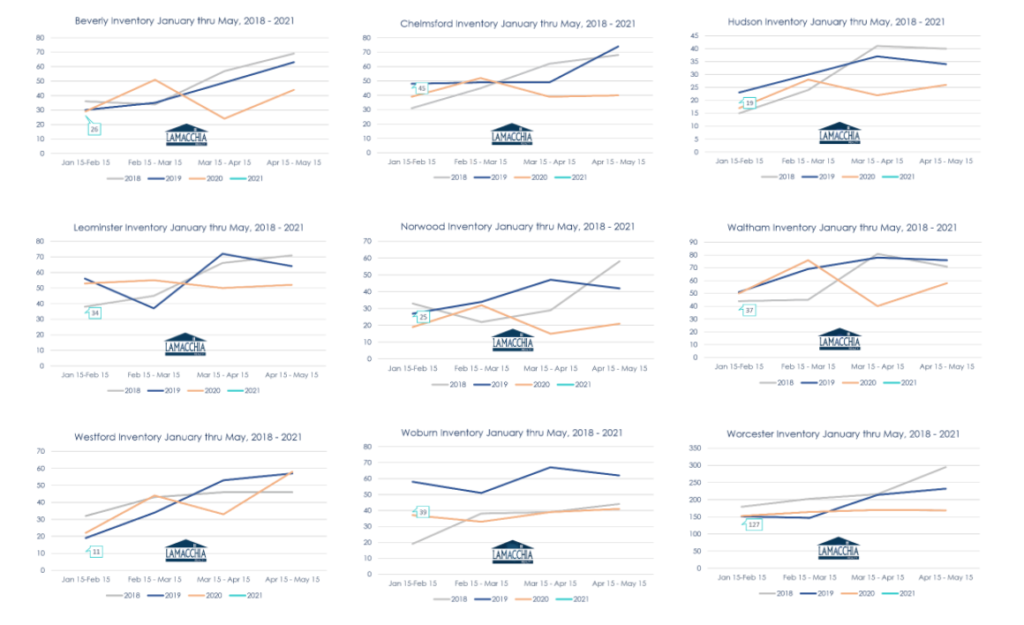Listing your home in the winter makes you more money. We talk about this all the time and this year is exacerbated by the anemic market perpetuated by the pandemic. Sellers hesitating to list due to COVID concerns along with a surge in buyer activity have made it so supply can’t keep up with demand. While the number of homes isn’t down much, the amount of available inventory is historically low. 2020 started with a 22.2% decrease from 2019, and 2021 has kicked off with a 35.5% decrease from 2020 with under 7,000 homes available on the market. As you can see in the chart below, we’ve been seeing a decrease in January inventory for the past couple of years, but the pandemic took that trend and widened the gap.
This graph shows January inventory over the last 25 years, On the Market Snapshot, pulled from MLS for every January 15th:

Inventory usually follows the same path that it always takes: lowest in winter, increases in spring until it peaks in mid to late summer, and then by fall, it drops dramatically. As you can see in 2020, the trend was rerouted in March (week 13) when the stay-at-home orders were instituted and so we didn’t see the usual rise in inventory from weeks 15 through week 40 (March thru September). We saw those little dips around the 4th of July and Labor Day and then the rise after Labor day before the fall’s decline. 2021 started significantly lower than 2020 but the trend for more inventory is likely to begin its rise in a couple of weeks. See below.
This graph shows weekly inventory year over year going back to 2014:

As you can see in the graph above in red, 2020 inventory, which was at 9,951 homes on February 3, 2020, was at a significantly lower point than any start to recent years, and February 3, 2021, was 37% lower at 6,299. Though this year the path has started at such a low point, we are hopeful that it will follow the same trends that we’ve seen for the past few years with the exception of 2020. Inventory levels directly correlate to the seller’s market vs buyer’s market phenomenon, when the market shifts in and out of favor depending on the season.

Why Does This Happen?
Inventory and the number of buyers translates to supply and demand, and in real estate, the rules are the same as anywhere else. If there’s greater supply than the number of buyers, the more buyers have to choose from and the more they can negotiate on price terms, making it a buyer’s market which we tend to see in the later months of the year.
Less supply (which is currently an understatement) and a greater number of buyers give the sellers the upper hand which is exactly the state of the current market and the supply of buyers will only grow larger in the weeks ahead. Buyer activity is strong despite winter because a lot of them wanted to buy months ago but couldn’t secure the home they wanted. These buyers have likely been involved in bidding wars, waited in long lines to get into open houses, and are at this point as frustrated as they are motivated. The historically low-interest rates are helping buyers because it gives them more spending power despite the rising prices. Buyers always come out earlier than the majority of sellers and that is exactly what creates this imbalance of supply not keeping up with demand, a market condition we have named the “Pac-Man” Effect but have covered in greater detail with our 2020 inventory crisis blog.
This explains that when homes placed under agreement in the late winter/early spring end up with higher sales prices than if they go under agreement in the late spring/early summer. Buyers are willing to pay more to secure a home when inventory is low and competition is high. In the graph below, you see in previous years how prices slightly fall in early spring, increase from there through summer, and drop in fall when sellers need to be the ones to compete for buyers. 2019 and 2020, however, required sellers to make fewer price adjustments because demand remained high throughout the year with inventory consistently being consumed by avid buyers who were willing to pay what sellers wanted, so prices stayed relatively steady throughout the year.
This line graph illustrates the average home sale prices per month for the last 10 years. You can see that since 2014 prices have steadily increased year over year and the greatest increase in prices was in 2020 leading into a very high start to 2021:

Home sellers, particularly New Englanders, tend to think that selling in the spring or summer when flowers are blooming, and the sun is shining makes their home more appealing. But that’s not how it works- a home is more appealing when it’s the only one available in the neighborhood in the buyer’s price range. That is what sells homes.
Take a look at the increase in inventory from January 15th to May 15th in the towns below for 2018 through February 2021

What should I do?
If selling in the first half of the year is your plan, we strongly urge you to consider beginning to prepare your home for a winter sale now. The optimal time to list every year is usually anywhere between January 20th and March 15th when inventory is the lowest. Again, when there is less supply and higher demand that is when you get more for your listing. When there are more homes on the market, buyers don’t have to compete and offer over asking. As soon as March hits, it’s predicted that we are going to see the real estate market turn on like a switch and sellers start to list a lot more than we’ve seen in the past months.



